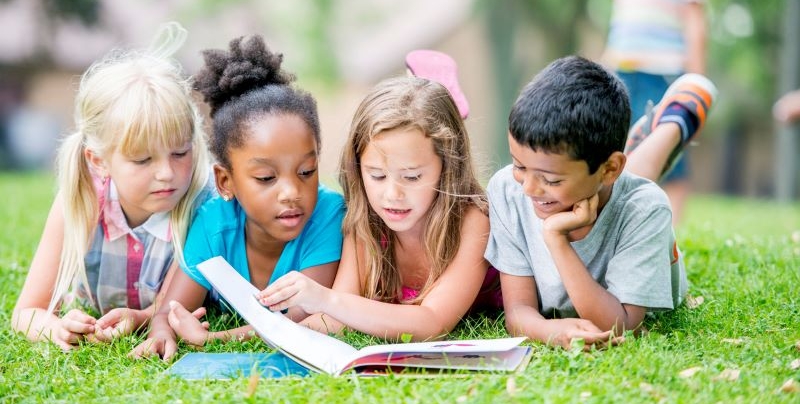| By Elizabeth Mohn |
Most educators realize the importance of reading to and with young students. Instilling a love of reading in young students can help them succeed academically and socially throughout their lives. Reading is a foundation of learning, and students who enjoy reading when they are young are more likely to read for enjoyment as they age.
Encouraging students to read during extended breaks from school, including summer break, can not only help inspire students to read for enjoyment but can also have the added benefit of helping students retain the academic advances they made during the school year. “Summer slide” is a term commonly used to describe the knowledge loss that happens among nearly all students during long summer breaks away from school. Students tend to lose knowledge in reading and math. Yet students who read throughout the break tend to lose less knowledge than those who do not.
Teachers can help their students prepare for summer break by inspiring them to seek as many reading opportunities as possible. They can inspire students to seek reading opportunities by introducing them to some of the new Gale In Context: Elementary literature resources. Gale In Context: Elementary has articles covering books for elementary students of all ages and interests.
Young and emergent readers might be most interested in learning about picture books they could read over the summer. For example, teachers could introduce readers to the new articles about the picture book Carmela Full of Wishes. This book was written by Matt de la Peña and illustrated by Christian Robinson—the same team that created the award-winning picture book Last Stop on Market Street. Teachers can guide students to accessing the Level 1 or Level 2 articles, depending on students’ reading ability.
Teachers could guide students to the new articles about Bee-Bim Bop!, a picture book written and illustrated by Linda Sue Park. The story is about a young girl who makes a traditional Korean dish with her family. Students can learn from the article about Park, who has written numerous other books, including picture books and novels. Teachers might also encourage students to read articles about the classic picture book Blueberries for Sal, which won the Caldecott Medal in 1949. The book, by author and illustrator Robert McCloskey, tells an exciting story about a young boy picking blueberries with his mother.
Older elementary students may be more interested in reading chapter books or novels rather than picture books. Teachers can guide these students to new articles about the well-known Judy Blume novel Tales of a Fourth Grade Nothing. The book is about a fourth grader named Peter and his mischievous younger brother. Teachers can let students interested in Tales of a Fourth Grade Nothing know that Blume wrote other books about Peter and his family. Teachers may be interested in introducing students to the verse novel Flipping Forward Twisting Backward, about a competitive gymnast dealing with dyslexia. The articles also tell about the author, Alma Fullerton, who is dyslexic. Finally, teachers might introduce students to new articles about author Neil Gaiman’s young adult novel The Graveyard Book. It’s about a young boy who is adopted by ghosts after his family is killed.
The new Gale In Context: Elementary literature resources also include articles about several popular graphic novels. Some students, especially visual learners, may be reluctant to pick up a traditional chapter book or novel. However, these learners may be interested in graphic novels, such as the award-winning graphic novel New Kid by artist and author Jerry Craft. It made history by becoming the first graphic novel to win the Newbery Medal. New Kid is a popular book in part because its story includes themes—such as identity, friendship, and prejudice—in which many students are interested. Teachers could guide students to read new articles about the graphic novel Pashmina. The book, by writer and artist Nidhi Chanani, is about a young girl named Pri who finds a magical pashmina and learns about growing up and herself.
Teachers might also consider introductory nonfiction books that could pique students’ interest. For example, students interested in libraries and books, Black history, or biographies might want to read the article about Schomburg: The Man Who Built a Library. The biography is about Arturo Schomburg, who collected books about African and African American history. Likewise, students who are looking for a meaningful but age-appropriate story about the Tulsa Race Massacre may be interested in an article about Unspeakable: The Tulsa Race Massacre. Author Carole Boston Weatherford and illustrator Floyd Cooper wanted to write this book to help teach students about an important, painful event in U.S. history.
Students could be inspired to read after learning about famous authors. Gale In Context: Elementary has numerous new resources about famous authors. The new Maya Angelou portal includes resources about one of the most famous authors in the United States in the twentieth century. Students can read Angelou’s biography in the portal or look at the portal’s Related Topics, such as the Amanda Gorman portal. Students can also read about contemporary authors, such as Matt de la Peña. De la Peña is the author of several picture books and young adult novels.
Teachers can help their students find resources about numerous other books, stories, and authors in Gale In Context: Elementary and inspire them to read now and in the future.

About the Author
Elizabeth Mohn is a writer and an educational content developer. When she’s not reading or writing, Elizabeth is usually spending time with her family, listening to podcasts, or working in her garden.


